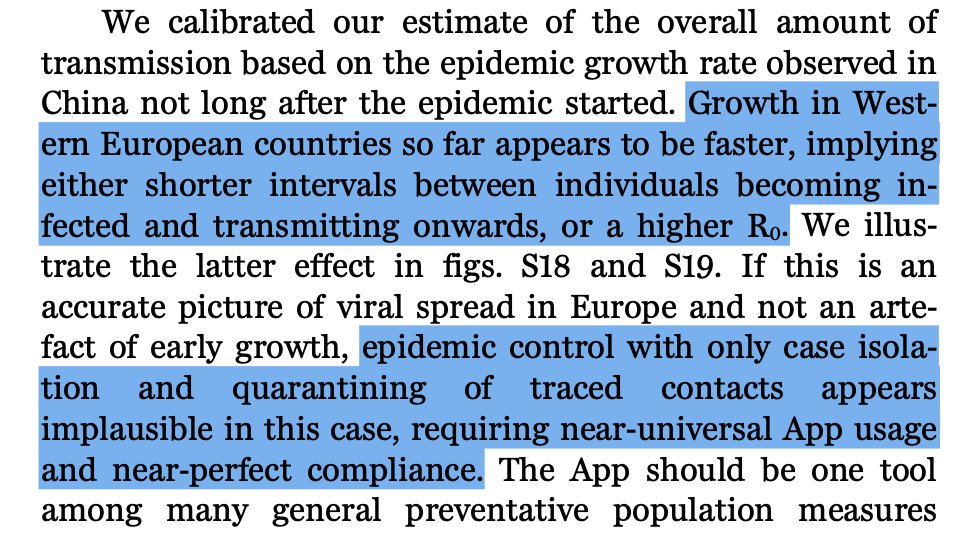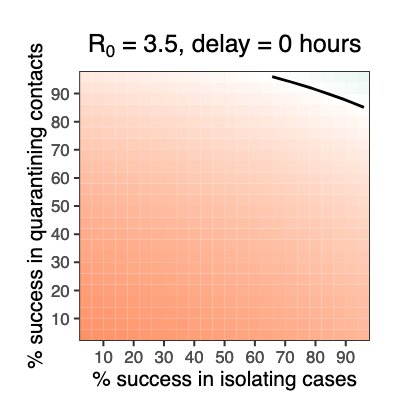Privacy researchers, govts, and tech companies work on contact tracing apps, hoping to curb down the pandemic. We often hear that 56, 60, or 70% of the population would need to install these apps. These are likely incorrect reads of a paper published by Ferretti et al. Thread  https://abs.twimg.com/emoji/v2/... draggable="false" alt="⤵️" title="Arrow pointing rightwards then curving downwards" aria-label="Emoji: Arrow pointing rightwards then curving downwards"> https://twitter.com/Telegraph/status/1254387257982758913">https://twitter.com/Telegraph...
https://abs.twimg.com/emoji/v2/... draggable="false" alt="⤵️" title="Arrow pointing rightwards then curving downwards" aria-label="Emoji: Arrow pointing rightwards then curving downwards"> https://twitter.com/Telegraph/status/1254387257982758913">https://twitter.com/Telegraph...
A team lead by Prof. Fraser at Oxford published a detailed and insightful study on 31/4/20: https://science.sciencemag.org/content/early/2020/04/09/science.abb6936
They">https://science.sciencemag.org/content/e... propose an empirical model with various parameters, to measure the impact of isolating symptomatic cases and quarantining their contacts. No 56/60/70 inside.
They">https://science.sciencemag.org/content/e... propose an empirical model with various parameters, to measure the impact of isolating symptomatic cases and quarantining their contacts. No 56/60/70 inside.
Fig. 3 is often discussed online. It shows that immediate contact tracing can curb the pandemic by itself, if we isolate 80% of symptomatic cases and quarantine 40% of contacts *immediately*, or 50/60%, or 20/70%, etc.  https://abs.twimg.com/emoji/v2/... draggable="false" alt="⚠️" title="Warning sign" aria-label="Emoji: Warning sign"> BUT…
https://abs.twimg.com/emoji/v2/... draggable="false" alt="⚠️" title="Warning sign" aria-label="Emoji: Warning sign"> BUT…
It needs to be nuanced:
— there are confidence intervals in the panels of Fig 3
— it& #39;s based on a very specific empirical dataset to train the model (“early stages of the epidemic in China”)
— the authors note that this might not be generalised to Europe https://abs.twimg.com/emoji/v2/... draggable="false" alt="😬" title="Grimacing face" aria-label="Emoji: Grimacing face">
https://abs.twimg.com/emoji/v2/... draggable="false" alt="😬" title="Grimacing face" aria-label="Emoji: Grimacing face">
— there are confidence intervals in the panels of Fig 3
— it& #39;s based on a very specific empirical dataset to train the model (“early stages of the epidemic in China”)
— the authors note that this might not be generalised to Europe
So why do we hear that 60% of the pop need to install the app vs. the “near-universal App usage and near-perfect compliance” in the Discussion section?
The model assumes a reproduction number R0 of 2.0: infected, I& #39;ll contaminate 2 people. With confidence intervals of 1.7-2.5!
The model assumes a reproduction number R0 of 2.0: infected, I& #39;ll contaminate 2 people. With confidence intervals of 1.7-2.5!
A recent study from France (not yet peer reviewed) shows that this reproduction number could have been as high as 3.3 before the French lockdown: https://hal-pasteur.archives-ouvertes.fr/pasteur-02548181
Ferretti">https://hal-pasteur.archives-ouvertes.fr/pasteur-0... et al. illustrate this high R0 in supplementary materials (Figs S18 and S19).
Ferretti">https://hal-pasteur.archives-ouvertes.fr/pasteur-0... et al. illustrate this high R0 in supplementary materials (Figs S18 and S19).
Oxford researchers also suggested FT to use a high R0 of 3.5 for their modelling in https://www.ft.com/content/f9fbc64c-4473-4109-b6d3-737936d6805d">https://www.ft.com/content/f...
If you go back to Fig S19, that would mean that with immediate contact tracing, 100% success in isolating cases and 85% in quarantining contacts might be needed in Europe. With a delay of 24h, it seems impossible.
Is that possible given our smartphone penetration rate?
Is that possible given our smartphone penetration rate?
My takeaway as a privacy researcher is that (A), as much as we focus on developing sensible tracking technologies, we should remember that these are unlikely to curb the pandemic alone (because “requiring near-universal App usage and near-perfect compliance”) and
(B) that we should be careful when using numbers such as “60%, 70%, 80% of the population will have to install these apps” because that might not reflect the findings of epidemiologists. Findings that evolve as days pass, new data emerge, and public policies change.

 Read on Twitter
Read on Twitter BUT…" title="Fig. 3 is often discussed online. It shows that immediate contact tracing can curb the pandemic by itself, if we isolate 80% of symptomatic cases and quarantine 40% of contacts *immediately*, or 50/60%, or 20/70%, etc. https://abs.twimg.com/emoji/v2/... draggable="false" alt="⚠️" title="Warning sign" aria-label="Emoji: Warning sign"> BUT…" class="img-responsive" style="max-width:100%;"/>
BUT…" title="Fig. 3 is often discussed online. It shows that immediate contact tracing can curb the pandemic by itself, if we isolate 80% of symptomatic cases and quarantine 40% of contacts *immediately*, or 50/60%, or 20/70%, etc. https://abs.twimg.com/emoji/v2/... draggable="false" alt="⚠️" title="Warning sign" aria-label="Emoji: Warning sign"> BUT…" class="img-responsive" style="max-width:100%;"/>
 " title="It needs to be nuanced:— there are confidence intervals in the panels of Fig 3— it& #39;s based on a very specific empirical dataset to train the model (“early stages of the epidemic in China”)— the authors note that this might not be generalised to Europe https://abs.twimg.com/emoji/v2/... draggable="false" alt="😬" title="Grimacing face" aria-label="Emoji: Grimacing face">" class="img-responsive" style="max-width:100%;"/>
" title="It needs to be nuanced:— there are confidence intervals in the panels of Fig 3— it& #39;s based on a very specific empirical dataset to train the model (“early stages of the epidemic in China”)— the authors note that this might not be generalised to Europe https://abs.twimg.com/emoji/v2/... draggable="false" alt="😬" title="Grimacing face" aria-label="Emoji: Grimacing face">" class="img-responsive" style="max-width:100%;"/>




